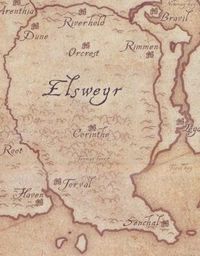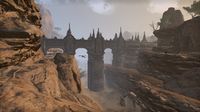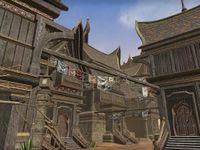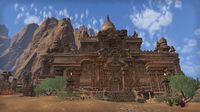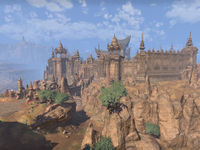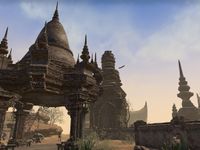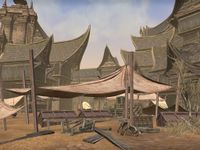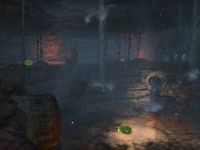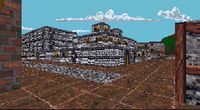Lore:Orcrest
| Orcrest | |
|---|---|
| Type | Settlement |
| Continent | Tamriel |
| Province | Elsweyr |
| Region | Anequina (The Scar) |
| Appears in | Arena, ESO |
|
Orcrest (/ˈɔːr.krɛst/ orr-crest) is one of the eight major cities in the province of Elsweyr,[1] situated over the barren wastes of the Scar. In modern history, Orcrest is known as the center of commerce for the northern kingdom of Anequina, attracting merchants and people from all over the region and beyond.[2] In the province's ancient history as the sixteen kingdoms, Orcrest was a kingdom of rogues and thieves.[3][4]
Layout and Geography[edit]
Orcrest is located in central Anequina, on a plateau and cliff face in the middle of the Scar canyon. It is completely surrounded by the steep ravine, only connected to the region's main roads by a large stone bridge over the canyon.[5] This great bridge connects the two disparate areas of northern Elsweyr,[2] the high savannahs near the Prowl and the Tenmar borderlands near the Merryvale moon sugarcane fields.[5]
In modern times, there a scant few settlements outside of the city, except for the Desert Wind Adeptorium to the northwest and the Stitches, a shantytown that draws northern Elsweyr's criminals and malcontents,[6] and established from the former kingdom of Meirvale.[7] Much of the land is filled with ruins, such as the structures in the Ashen Scar and the Weeping Scar. It is also populated by desert creatures, such as harpies and terror birds in the lower canyon.[5] Orcrest is neighbored by several settlements, such as Kings Walk to the north-northeast and Neumar Walk to the south-southwest.[1]
Orcrest is a walled city divided into four sections: the Lower City, the Market District, Red Senche Alley, and the Upper City. From the city's gate is the Market District, a sprawling area of caravans and merchant stalls.[5] In its prime, Orcrest's bazaar is like a jewel in the Scar desert and brims with activity.[8] From here, the city diverges northeast and southeast to the Lower City and Red Senche Alley, respectively. Each district is mostly a narrow corridor filled with homes and meets the Upper City to the east. This fairly open parkland area has short walls around its streets. On its northeast corner is the town hall,[5] a fairly large manor that, in times of plague and famine, was used to quarantine people. Anyone who suffered physically and mentally was left in its lower halls to be locked away and forgotten.[9] The Orcrest Sewers is built under the city and connects across the Lower City, Market District, and Red Senche Alley.[5]
Notable Locales[edit]
Districts[edit]
|
History[edit]
Early History[edit]
Orcrest, like the rest of the sixteen kingdoms, was originally a nomadic clan that cemented itself by mastering a specific skill or trade, and ultimately, swore fealty to the ancient Moon-Emperor. But as time passed, the clans were forced into their roles and limited geographies,[12] with the original clan of Orcrest establishing itself as rogues and thieves.[3][4] The clan settled in central-northern Elsweyr, in a desert region known as the Scar, named after the eponymous canyon.[5] The Scar itself is the subject of legends, with some claiming it was created by either Alkosh, the Khajiiti God of Time, or Khunzar-ri, the mythical hero of ancient Elsweyr.[13]
In the Merethic Era, Orcrest and the sixteen kingdoms were competing fiefdoms ruled by a cruel hunter-aristocracy. In northern Elsweyr, severe droughts and famines were constant and the many skirmishes between Hunt-Lords meant that the peasantry were always drafted for war. The only ones that had any push back against the Hunt-Lords was the Temple of Two-Moons Dance, and its adepts and Torval clergy who wielded significant cultural influence. Years after Takanzin the Striped-Death's hired attack of the Rawl'kha temple and the Hunt-Lords' subsequent suppression of any religious order, the adepts went into hiding and developed the martial tradition of claw-dances. By the late days of the Merethic Era, the peasantry finally revolted against the Hunt-Lords after one of the worst famines in Khajiiti history. One of these uprisings broke out in Orcrest, and within a century, the regal hunter caste was abolished and a new kind of nobility was established thereafter.[14]
In time, the Kingdom of Orcrest prospered, but with the advent of Thrassian Plague of 1E 2200, the sixteen kingdoms faced a mass number of deaths, and their tribal functions had to change forcibly. Orcrest and the northern kingdoms fell in with the Kingdom of Ne Quin-al, or more commonly known by its Cyrodilic name, Anequina, who were nomads of arid deserts. The new patchwork of former kingdoms resumed ancient tribal traditions and customs, unlike the southerners in Pellitine, who took on aspects of foreign cultures.[12][15] Orcrest under the Kingdom of Anequina became a center of commerce and a place for the rest of Anequina to congregate.[2]
The Knahaten Flu and Onward[edit]
In 2E 560, the Knahaten Flu began its devastating spread across Tamriel.[16] It was only five years later in 2E 565, did the flu first appear in Elsweyr via the Black Kiergo slums of Senchal.[17][18] Within a moments notice, it spread across the entire province, including Orcrest.[17] But of the cities affected by the Knahaten Flu in northern Elsweyr, Orcrest suffered the most.[19] No one knows how the flu arrived into Orcrest, or who was responsible for creating it, with some blame going toward the Argonians or even Peryite, the Daedric Prince of Pestilience. As more people died from the disease, bodies were piled up, and while some tried to flee the city, rumors claimed it was much worse outside.[20] Volunteers from across the land, such as Ubraz, a talented alchemist of his time, traveled to Orcrest in late Sun's Dusk to treat victims but the disease was evidently too potent, and took their lives as well.[21][22]
Taking advantage of the Khajiits' weakened state, war broke out as the Colovian Estates annexed most of northern Elsweyr.[Note 1] Orcrest and nearby Riverhold were taken over by the Colovians, but a resistance force led by the warrior Namu charged in to retake them. Though she died in battle to General Quintilius, Orcrest and Riverhold were reclaimed[23] but Orcrest's damage from the Knahaten Flu was too severe, and for several years since then, it was abandoned, left to rot and deemed haunted by the surviving populace.[19] By 2E 582, as the rest of Elsweyr recovered, nothing had changed in Orcrest. But even so, people still lived in the city and were affected in more ways than one by the flu. Those that survived barely scraped by and hid, but others went mad and resorted to extreme tactics. Some became obsessed with burning the city and using fire, while others resorted to cannibalism, like a group who lived in the ruined Red Senche Alley and were led by their so-called cannibal king, the Pahmar-raht named Eludin.[5]
In 2E 582, a group of Peryite worshippers traveled to Orcrest to find evidence that their Lord was responsible for the city's destruction. With help from an adventurer, they succeeded in their mission, while the adventurer rescued a few people still stuck in the city.[24] In time, Orcrest recovered and was re-populated. During the Imperial Simulacrum in the late Third Era, the city-state of Orcrest was an active settlement. It was ruled by King Amtaba and had a rivalry with Riverhold.[11]
Known Rulers[edit]
The Sovereign of Orcrest
The desert cats of the baking sand
The windblown rogues of Orcrest" —Excerpt from "The Sixteen Kingdoms"
As one of the sixteen clans, it was led by a clan leader.[18] Up until the late Merethic Era, Orcrest and the sixteen kingdoms were fiefdoms ruled by Hunt-Lords, until they were overthrown by the peasantry.[14] By the late Third Era, Orcrest was ruled by a King/Queen, who typically ruled a surrounding kingdom.[11] In the traditional Khajiiti child's chant, The Sixteen Kingdoms, Orcrest's ruler is referred to as the Sovereign of Orcrest.[4]
Culture and Society[edit]
Orcrest, in its ancient history, was a place that gathered thieves and rogues.[4] The Cat-King of Thieves, Rajhin visited the city before his ascension into godhood. One of his shadows claims that he never felt so welcome in a place like this.[3] Today his original home of Senchal is known as a place for criminal activity,[25] while Orcrest is known now as a positive hub of activity. It is said that a Khajiit will part ways with their tail here if it were for the right price.[2] The story of how Orcrest and its original clan of Khajiit acquired its name is told in the lullaby Hasa Zha'ja. Likewise, the transition of clan name to place name is described in a poem called Zhan Zhab, written by a clanless Khajiit in 1E 2243.[12] A common exclamation is "Dust of Orcrest".[26] Some of Orcrest's regional foods and drinks include agony pale ale[27] and garlic apple jelly.[28]
Many different creatures live in Orcrest, such as the local jerboa, who live in small nooks and crannies throughout the city.[29] The Orcrest Rathound is a favorite among beggars as they make excellent scavengers. Survivors of the Knahaten Flu in Orcrest claim that the rathound's uncanny ability to sense danger led them to exodus out of the city before the flu destroyed it.[30]
The King of Anequina at the time of its unification with Pellitine, Keirgo had an honor guard based in Orcrest. During his wedding ceremony with Queen Eshita of the south, the Orcrest Honor Guard was there and mounted on twenty white lions, a highly prestigious mount in Elsweyr.[31] The Orcrest Sewers, even when the city was abandoned, were rife with wildlife but also rumored monsters like Noordigloop the Clog, a giant voriplasm that was transported from Murkmire in Black Marsh and escaped during the Knahaten Flu.[32]
One of Orcrest's most well-known residents was the famous tapestry maker named Cherim. His first masterpiece was called the Heart of Anequina, which depicted a momentous battle during the Five Year War that he was involved in. Emperor Uriel VII owned at least ten of his tapestries, and his subjects were usually historical moments throughout Tamriel, like the Fall of White-Gold Tower and the Velothi Exodus.[10]
Gallery[edit]
Notes[edit]
- Arena was originally conceived as a fighting game featuring a tournament that took the player to each of Tamriel's cities to challenge different gladiatorial teams. According to a file from that stage of development left behind in the final game, Orcrest's gladiatorial team would have been called "the Silent Ones".[UOL 1]
See Also[edit]
- For game-specific information, see the Arena and Elder Scrolls Online
 articles.
articles.
Books[edit]
- First Signs of the Flu — An Orcrest citizen's thoughts on the Knahaten Flu
- Noordigloop the Clog — Notes on a rogue Voriplasm
- The Sixteen Kingdoms — A traditional chant about the sixteen kingdoms of ancient Elsweyr
References[edit]
- ^ a b Map of Elsweyr – The Elder Scrolls: Arena
- ^ a b c d Guide to Northern Elsweyr — Infrasia Mallius
- ^ a b c Rajhin's Shadow's dialogue in ESO: Elsweyr
- ^ a b c d The Sixteen Kingdoms
- ^ a b c d e f g h i j k l m Orcrest in ESO: Elsweyr
- ^ Isadati's dialogue in ESO: Elsweyr
- ^ Meirvale Keep loading screen text in ESO
- ^ Zerith-var's dialogue in ESO
- ^ a b High Cantor Viti's dialogue in ESO
- ^ a b Cherim's Heart of Anequina — Livillus Perus, Professor at the Imperial University
- ^ a b c d e Orcrest location and rumors in Arena
- ^ a b c Anequina and Pellitine: An Introduction — Sulema, Initiate Scholar of the Pa'alatiin
- ^ Zamarak's dialogue in ESO: Elsweyr
- ^ a b Origins of the Khajiiti Martial Tradition — Tendwuayne, Sapiarch of Foreign Customs
- ^ Pocket Guide to the Empire, 3rd Edition: Sugar and Blood: the Cats of the South — Imperial Geographical Society, 3E 432
- ^ Pocket Guide to the Empire, 3rd Edition: The War with the Trees: Argonia and the Black Marsh — Imperial Geographical Society, 3E 432
- ^ a b The Eagle and the Cat — Lord Gharesh-ri, Speaker for the Mane
- ^ a b History of Senchal: An Overview — Sulema, Initiate Scholar of the Pa'alatiin
- ^ a b Orcrest loading screen text in ESO: Elsweyr
- ^ First Signs of the Flu
- ^ Shazah's dialogue in ESO
- ^ Shazah's Diary — Shazah
- ^ Khali's dialogue in ESO
- ^ Unhealthy Preoccupation quest in ESO: Elsweyr
- ^ Pocket Guide to the Empire, 1st Edition: The Elsweyr Confederacy — Imperial Geographical Society, 2E 864
- ^ Khajiit exclamations in Arena
- ^ Orcrest Agony Pale Ale in ESO
- ^ Orcrest Garlic Apple Jelly in ESO
- ^ Orcrest Jerboa in ESO
- ^ Orcrest Rathound in ESO
- ^ White Lion mount description in ESO
- ^ Noordigloop the Clog
Note: The following references are considered to be unofficial sources. They are included to round off this article and may not be authoritative or conclusive.

